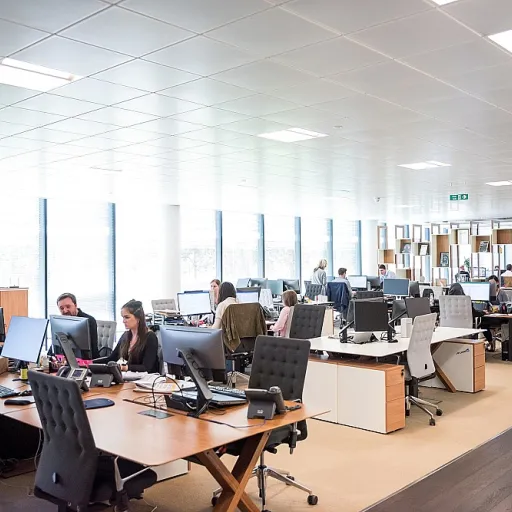
The Role of a Workplace Experience Manager in Remote Settings
Understanding the Position of Workplace Experience Managers
In the realm of remote work, the role of a workplace experience manager is evolving rapidly. Traditionally, this position was largely associated with maintaining an efficient physical workspace and managing facilities. However, with the rise of remote and hybrid work settings, the focus has shifted significantly. Experience managers now play a crucial role in shaping employee experience and engagement in a virtual environment. Remote work has transformed the conventional office into a digital landscape, requiring experience managers to adopt new strategies. They must ensure that their companies leverage digital tools and technology effectively to create a virtual culture that mirrors the camaraderie and collaboration of an in-person office. This means facilitating seamless operations not just for those in San Francisco or any central office locations, but for all remote employees globally. Moreover, experience managers collaborate closely with other sectors, including HR and the vice president of operations, to bridge the gap between physical space and digital platforms. This partnership supports an employee engagement strategy conducive to a productive workplace, where employee satisfaction and retention are prioritized. For companies hiring or already employing remote teams, understanding the nuances of this managerial role is vital. The support lead within a company not only aids in effective space utilization but also enhances workplace management, ultimately driving the success of employee engagement initiatives. To delve deeper into how companies are navigating these changing dynamics, exploring resources on the dynamics of a distributed workforce can provide further insights.Creating a Virtual Culture: Challenges and Solutions
Building Connections in a Virtual Workspace
Creating a cohesive virtual culture presents unique challenges for managers and employees alike. With traditional office environments becoming less common, managers are faced with the task of fostering engagement and connectivity in a digital landscape. Maintaining effective communication is paramount, as it builds a bridge between remote and office employees. Workplace managers must employ robust communication platforms and regularly scheduled video check-ins to ensure every team member is engaged and heard.Encouraging Employee Engagement and Collaboration
An experience manager plays a crucial role in nurturing a sense of belonging and purpose among the workforce. This role involves the integration of virtual team-building activities and social events that mimic the informal interactions typically found in an office setting. Such initiatives support the development of trust and camaraderie, thereby enhancing employee satisfaction and retention. Effective managers leverage creative strategies to bolster employee engagement, which has a direct impact on a company’s operations and success.Overcoming Remote Work Hurdles
Challenges such as feeling isolated and disconnected can lead to decreased productivity and morale. By devising thoughtful strategies, such as encouraging open communication and creating virtual spaces for casual interactions, companies can combat these issues effectively. Moreover, the dynamics of a remote and hybrid work environment can be better understood by exploring how to create a positive employee experience, ultimately benefiting the company's environment more comprehensively. For more insights into these dynamics, consider visiting this resource on office dynamics. By addressing these challenges head-on, a workplace manager not only cultivates a strong virtual culture but also ensures that employees remain connected, motivated, and aligned with the company’s goals.Tools and Technologies for Remote Work Success
Leveraging Technology for a Seamless Remote Work Environment
In today's dynamic business landscape, tools and technologies play a pivotal role in enabling remote work success. The adoption of these solutions not only enhances operational efficiency but also improves the overall employee experience and engagement, fostering a seamless transition to hybrid work models. To effectively manage a distributed workforce, companies are increasingly investing in advanced communications tools. Platforms such as Slack, Zoom, and Microsoft Teams have become essential for facilitating real-time collaboration and communication among remote teams. These tools mimic the immediate interactions found in traditional office environments, allowing employees to engage with each other and with managers effectively. Beyond communication, the utilization of project management tools like Asana, Trello, and Monday.com streamlines workflow operations. These solutions offer capabilities that assist managers and support leads in tracking project progress, aligning team objectives, and ensuring timely deliverables even when staff members are not co-located. For an experience manager, ensuring smooth workflow and space utilization across various projects is critical to achieving workplace strategy objectives. Equipping employees with the right technology is crucial, but it is also important to offer ongoing support and training. Companies should focus on initiatives that empower employees to maximize these tools' potential, consequently enhancing job satisfaction and efficiency. Effective training programs and resources not only increase software proficiency but also bolster employee support networks, essential for nurturing a positive remote workplace culture. To further bolster the remote workspace, companies are exploring solutions beyond traditional software. Virtual office environments and virtual reality platforms are emerging as innovative methods for facilitating immersive meetings and creative brainstorming sessions, which were primarily in-person activities. Implementations of these technologies by forward-thinking organizations in San Francisco and beyond demonstrate the ever-evolving nature of remote work. The role of a workplace manager extends to overseeing the integration of these technological solutions and ensuring they align with company goals. By doing so, they help cultivate an adaptive remote working environment that keeps employees engaged and productive. In conclusion, technology is the backbone of effective remote work management. By strategically deploying the tools and technologies discussed, companies can continuously enhance employee experience even in a virtual setting. For more insights on maintaining a positive and inclusive company culture, explore navigating the use of foul language in remote work environments.Employee Well-being and Engagement Strategies
Nurturing Employee Connection and Satisfaction from Afar
Employee well-being and engagement strategies are pivotal in the virtual workplace environment, an essential part of effective workplace management. Experience managers play a crucial role in fostering connection and understanding employees' needs in remote settings.
Creating a sense of belonging and satisfaction among employees requires more than just occasional check-ins. Consider the following strategies to enhance employee engagement and connection:
- Frequent Communication: Regular meetings using video conferencing tools can help bridge the gap between isolated team members, enhancing the employee experience by allowing them to connect and share ideas.
- Virtual Team Building Activities: Organize activities that engage employees and promote interaction, improving team cohesion and morale, which is especially important when employees are spread out beyond traditional office locations like San Francisco.
- Employee Feedback Platforms: Use tools that allow employees to give continuous feedback, aiding managers in assessing employee satisfaction and identifying areas that require attention. Prompt responses to feedback can significantly improve the employee-employer relationship.
Experience managers are tasked with supporting employees, focusing on aspects of workplace strategy and employee satisfaction. For example, operations in companies can use data on employee engagement to tailor solutions effectively, which involves a fusion of traditional facilities management with modern approaches.
Organizations must also create methods to nurture hybrid work models, aligning with their workplace strategies and supporting the idea that engagement and well-being are crucial for productivity. In doing so, employee satisfaction can be significantly increased, leading to a more robust remote work environment.
Measuring Success: Key Metrics for Remote Work Environments
Key Performance Indicators for Evaluating Remote Work Environments
Evaluating the efficacy of remote work environments is essential for companies aiming to maintain high levels of productivity and employee satisfaction. Measuring success in such settings requires a carefully curated set of key performance indicators (KPIs) that help managers and workplace experience leaders effectively track and improve operations.- Employee Engagement: Monitoring employee engagement is crucial for understanding how workers are interacting with the company's initiatives and culture. Surveys and regular feedback sessions can provide actionable insights that managers need to ensure employees feel connected and motivated.
- Productivity Levels: Despite the absence of a physical office setting, tracking productivity levels remains important. Utilizing project management tools and regular performance reviews helps employees stay aligned with the company's goals, while enabling managers to identify areas for improvement.
- Employee Satisfaction: Understanding employee satisfaction can signal whether a company's remote work strategy is sustainable. Regular assessment of workers’ satisfaction through feedback can help prevent burnout and improve overall morale.
- Space Utilization: Even for companies adopting hybrid work models, efficient space utilization remains significant. Analyzing how office spaces are used during hybrid work schedules can inform facilities management decisions, optimizing operational costs and office layouts.
- Service and Support Feedback: Assessing how well support services cater to remote employees is vital. Ensuring that IT and HR services are easily accessible and effective can greatly enhance the employee experience and satisfaction levels.
Future Trends in Remote Work and Workplace Experience Management
Emerging Patterns and Innovations in Remote Workplaces
As companies across the globe continue to adapt to remote work, several emerging trends are reshaping the traditional workplace environment. The role of the workplace experience manager is evolving rapidly to meet these changes, adapting strategies to enhance employee satisfaction and management efficiency.- Hybrid Work Models: The hybrid work model has become a popular choice for many organizations, offering a balance between remote and in-office work. This approach enables employees to enjoy the flexibility of remote work while maintaining the collaborative benefits of an office space. Managers must develop comprehensive workplace strategies that effectively manage space utilization and integrate remote and on-site employees.
- Advanced Workplace Technologies: With the rise of remote work, companies are investing in advanced technologies to support their digital operations. Tools that facilitate seamless communication and collaboration have become essential, bridging the gap between employees and managers. These technologies also empower companies to track employee engagement and satisfaction.
- Enhanced Focus on Employee Engagement: In a remote setting, maintaining high employee engagement is critical. Experience managers are focusing on innovative solutions to boost employee involvement, such as virtual events and wellness programs, contributing to a positive workplace experience.
- Adaptive Leadership and Management Strategies: The role of a workplace manager now includes ensuring that management strategies are adaptive and forward-thinking. This means developing an understanding of virtual team dynamics to enhance employee experience and devising techniques for efficient remote management.
- Environmental and Sustainable Practices: As remote work dissolves the traditional office, companies are reconsidering their carbon footprint and environmental impact. Sustainable practices are observed, emphasizing remote policies that reduce unnecessary commuting, saving energy and resources.












